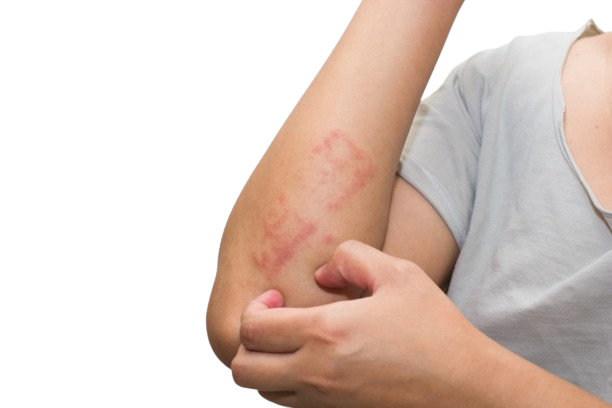Contact Dermatitis in Perumbakkam
Your Trusted Partner in Contact Dermatitis
Contact dermatitis is a rash on your skin that develops when you come into contact with something you’re allergic to or something that irritated your skin. We are here to provide you with top-notch care and guidance to tackle your problems.

Understanding Contact Dermatitis
What is contact Dermatitis?
Contact dermatitis is your skin’s reaction to something in your environment that causes an itchy rash. “Dermatitis” is the medical term for skin irritation or swelling (inflammation). You get contact dermatitis by coming into contact with a substance, organism, object or chemical that’s irritating to your skin.
What are the types of contact Dermatitis?
There are two types of contact dermatitis:
- Allergic contact dermatitis: Your body has an allergic reaction to a substance (allergen) that it doesn’t like. Common allergens include jewelry metals (like nickel), cosmetic products, fragrances and preservatives. It can take several days after exposure for an itchy rash to develop.
- Irritant contact dermatitis: This painful rash tends to come on quickly in response to an irritating substance. Common irritants include detergents, soap, cleaners and acid. Irritant contact dermatitis occurs more often than allergic contact dermatitis.
Who does contact Dermatitis affect?
Contact dermatitis can affect anyone at any age, from a baby to an adult. Skin reactions can occur after a single exposure or after repeated exposures over time.
People who work in certain professions have a higher risk of developing contact dermatitis if they repeatedly encounter irritating chemicals or allergens. Professions at a high risk of developing contact dermatitis include:
- Construction workers.
- Florists.
- Food handlers.
- Hairstylists.
- Healthcare providers.
- Janitors and plumbers.
- Mechanics.
- Artists.
What does contact Dermatitis look like?
Symptoms of contact dermatitis include a rash on your skin that’s:
- Red to purple or darker than your natural skin tone.
- Swollen hive-like or elevated from the skin surrounding it.
- Bumpy with a small cluster of pimples or blisters.
- Oozing fluid or pus.
- Painful with a burning or stinging sensation.
- Flaky or scaling.
- Itchy.
Scratching your rash could break open your skin and cause a wound. If this wound becomes infected, it will look red and crusty and may be painful or leak pus.
Where on my body will I have Symptoms of contact Dermatitis?
You can experience contact dermatitis anywhere that your skin came into contact with an allergen or irritant. The most common places that people experience symptoms include:
- Face, neck and scalp.
- Lips, eyelids and cheeks.
- Hands, fingers and arms.
- Genitals (penis, vaginal area and vulva).
- Armpits.
- Feet and legs.
What causes contact Dermatitis?
Physical contact with an allergen or an irritant causes contact dermatitis.
If your body doesn’t like something that touches your skin, your immune system responds. When you see your skin swell or become inflamed, that’s a sign that your white blood cells are responding to the allergen or irritant, which can cause an itchy rash. The rash may appear in minutes if it’s caused by an irritant, or may take hours or days to appear after exposure to an allergen.
How is contact Dermatitis Diagnosed?
Your healthcare provider will diagnose contact dermatitis after taking a complete medical history, performing a physical exam and reviewing your symptoms.
There isn’t a test to identify the cause of irritant contact dermatitis, but your provider will ask questions to learn more about your environment, things you’ve come into contact with and the location and size of your rash. These questions could include:
- How long have you had a rash?
- Did you make any changes to your normal skin care routine?
- Did you come into contact with any new plants, materials or chemicals?
- Do you have regular contact with any irritants or chemicals?
For allergic contact dermatitis, your provider may offer testing, including a patch test to confirm a diagnosis. For a patch test, your provider will place a sticky patch on your skin. That patch is coated in common allergens. When your provider removes the patch, they’ll be able to see if the allergens on the patch triggered an allergic reaction on your skin.
Although uncommon, your provider might perform a skin culture or biopsy where they take a sample of the tissue from your rash and examine it under a microscope.
How is contact Dermatitis treated?
Treatment for contact dermatitis is the same for both allergic and irritant types. Treatment could include:
- Avoidance: If you identify what caused the rash, avoid or minimize exposure to it.
- Taking medicine to relieve swelling and itching: Medicines could include over-the-counter anti-itch creams, topical or oral antihistamines corticosteroid creams or, prednisone an oral steroid. Immunosuppressant medications are uncommon.
Frequently Asked Question on contact Dermatitis?
You should see a doctor if the rash is severe, covers a large area, persists despite home treatment, or if you suspect an infection. Additionally, if you are unsure of the cause of the rash, seeking medical advice is recommended.
